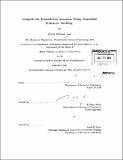Large-strain piezoelectric actuators using controlled structural buckling
Author(s)
Neal, Devin Michael
DownloadFull printable version (6.218Mb)
Other Contributors
Massachusetts Institute of Technology. Dept. of Mechanical Engineering.
Advisor
H. Harry Asada.
Terms of use
Metadata
Show full item recordAbstract
Buckling is a highly nonlinear and singular phenomenon in thin beams, and is usually an undesired characteristic that must be prevented from occurring in engineered systems. Buckling, however, can be a useful mechanism for gaining extremely large displacement amplification, since a infinitesimal displacement in the axial direction of the beam may lead to a large deflection in the middle of the beam. This thesis presents a novel large-strain piezoelectric actuator exploiting the buckling of a structure with imbedded piezoelectric stack actuators. The realization of this buckling actuator began by rethinking the paradigm of where PZT stacks are placed in traditional flexure-based displacement amplification mechanisms. Although the free displacement of a PZT stack is only 0.1% of the stack length, the buckling mechanism can produce a large bipolar displacement that is approximately 150 times larger than the original PZT displacement. Furthermore, the structural buckling produces a pronounced nonlinearity in output impedance; the effective stiffness viewed from the output port varies as a function of output displacement, which can be a useful property for those applications where actuator stiffness needs to vary. Buckling is controlled with phased activation of the input units and either 1) a strategically placed redirecting stiffness or 2) multiple buckling units working in parallel.
Description
Thesis (S.M.)--Massachusetts Institute of Technology, Dept. of Mechanical Engineering, 2009. Cataloged from PDF version of thesis. Includes bibliographical references (p. 59-60).
Date issued
2009Department
Massachusetts Institute of Technology. Department of Mechanical EngineeringPublisher
Massachusetts Institute of Technology
Keywords
Mechanical Engineering.